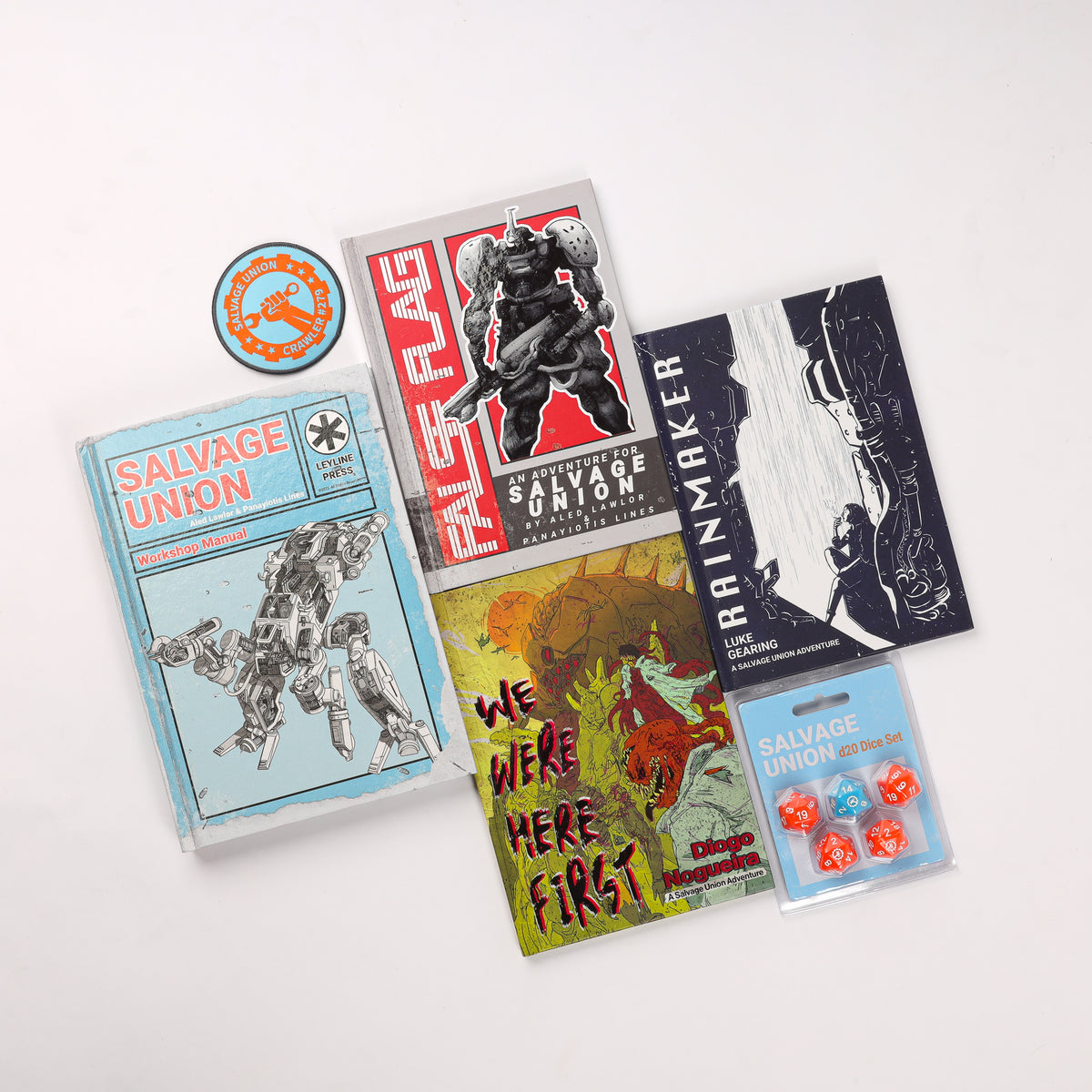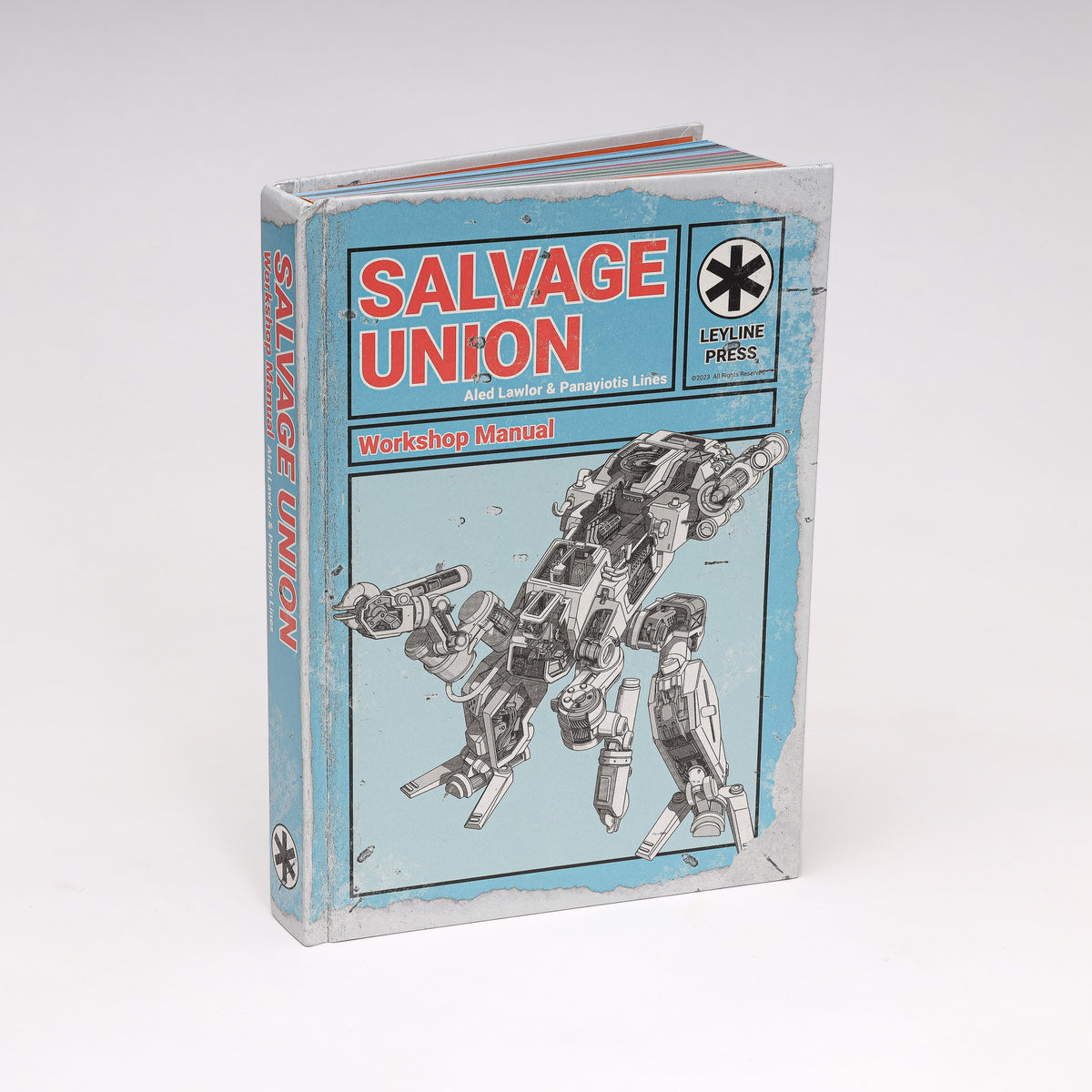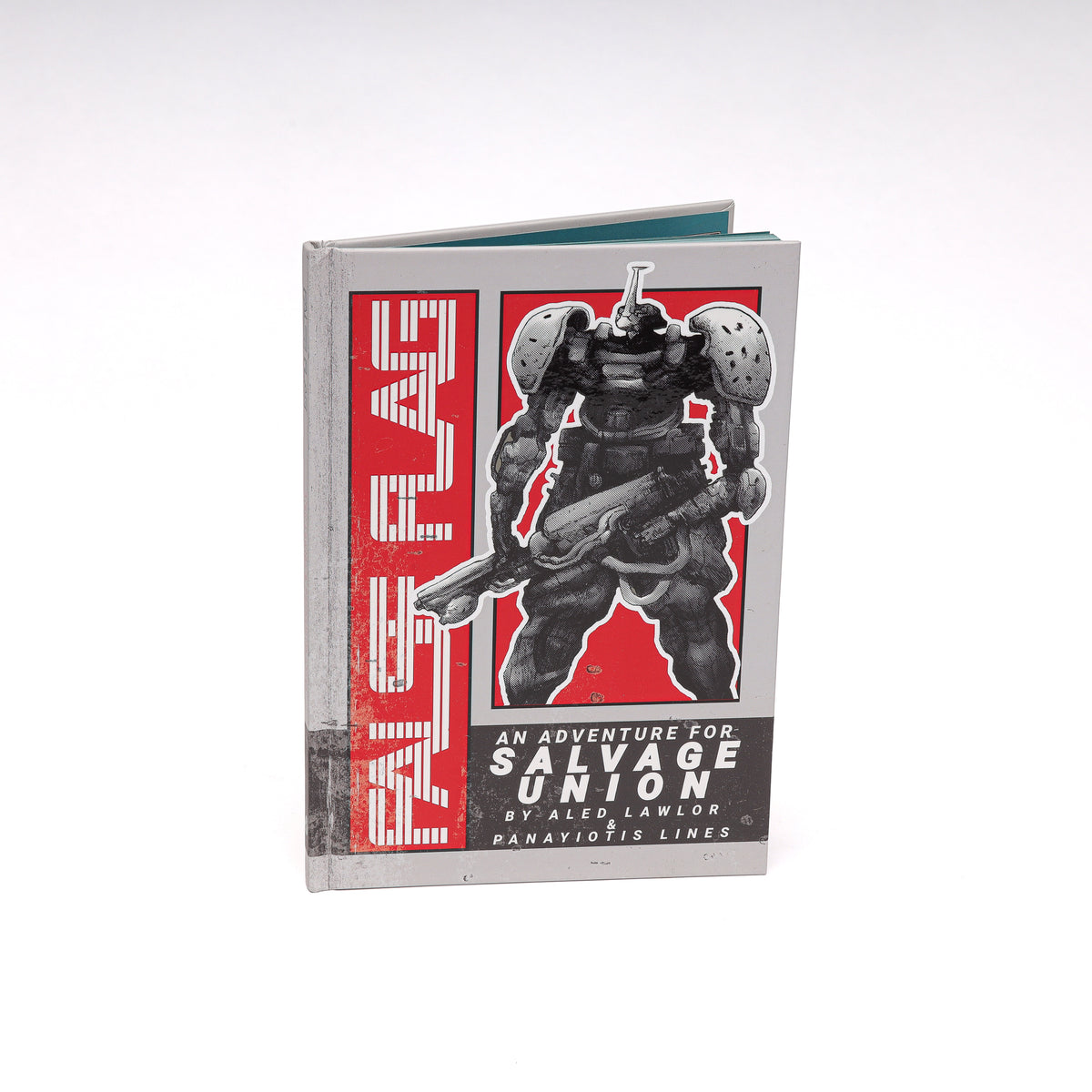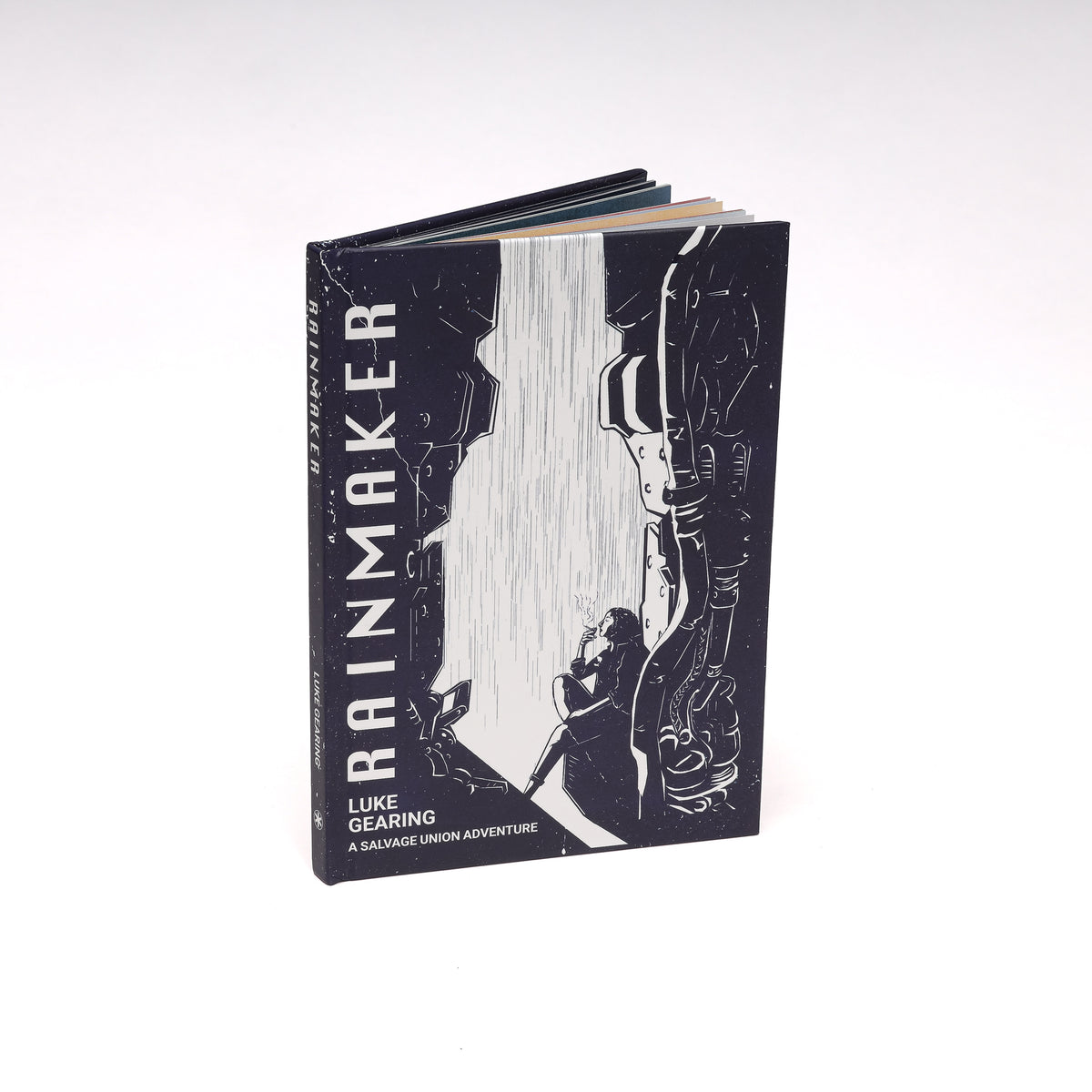
In this series of blogs we're exploring the various OSR RPG systems out there and how they compare to one another and the original D&D rules. Last week we took a look at The Black Hack.
This week we're exploring Dungeon Crawl Classics (DCC) by Goodman Games.
DCC merges old school principles and aesthetics with some more modern game design ideas. It's core mechanic is similar to the 'd20 system'. You roll a d20+ stat modifiers and compare this to a set 'Difficulty Class' or DC value. If you roll equal to our over the DC value you succeed, otherwise you fail. (They missed a trick by not calling it a DCC value amirite?)
The 'd20' system was introduced by Wizards of the Coast for Third Edition D&D (3.0) as a means to streamline the disparate resolution mechanics of Dungeons & Dragons into a cohesive whole. By the time of AD&D 2nd Edition,
which preceded D&D 3.0, the resolution mechanics of D&D were spread over a wide variety of systems and subsystems within the rules. The d20 system streamlined everything down to one dice roll.
This makes the core of DCC familiar to a modern D&D audience whilst still keeping vast amounts of old school flavour. The core system does make character stats more important, in a similar way to The Black Hack which uses a core d20 roll under system. It’s no coincidence that DCC uses the d20 system as it was designed with 3.0 compatibility in mind and uses its open SRD as a basis.
Don't however be mistaken and think DCC is simply a d20 system clone, it differs vastly from how the likes of 3.0 D&D and similar systems work in both it's variety of rule, aesthetic and style of play which are soaked in old school D&D.
One major change to the inherent structure of DCC is that characters begin their journey at level 0.Not only that but players create three characters to start their adventure with rather than the customary one character that has been the standard in every edition of D&D and most tabletop roleplaying games.
The intent is that your level 0 characters play through an adventure called a 'funnel' with the intention that only one of the three will survive to become a fully fledged level 1 character. This reinforces the principle of lethality within OSR style systems by having a session set up where effectively characters are created to die, which also stops players getting too attached to them and sets up the overall tone for the game.
Your level zero characters are built from an array of six ability scores. These roughly correlate to the classic six ability scores from original D&D.
Character Luck affects all sorts of things such as critical hit chances, fumbles and chance of being corrupted. Luck can effectively be 'burned' to allow characters to survive life or death moments and perform extraordinary actions known as 'Feats of Luck.'

These ability scores are rolled randomly 3d6 down the line in classic D&D fashion, producing broadly 'average' characters with one or two good stats. As your three starting characters are at level 0 you pick an occupation at random for each of them rather than a class. This is done via an extensive d100 table and represents quite literally your character's job.
They include the likes of Locksmiths, Merchants, Millers and Scribes. Each comes with a weapon the character is trained in such as a Knife for a Rope Maker and a trade good the character would have, the Rope Maker unsurprisingly has Rope, the Miller has Flour, the Urchin has a Begging Bowl and so on. Some of these occupations can also determine your character's race, of which the classic Dwarf, Elf and Halfling are included, so you might be a Dwarven Blacksmith or a Halfling Trader.

Anything else is assumed to be human. Your race is still your class as in Basic D&D so a Dwarven Blacksmith at level 0 becomes a Dwarf Class at level 1.Once you have your profession rolled up you pick an alignment from a choice of Lawful, Neutral and Chaotic mirroring the choice you have in both original D&D and Basic D&D.
Your level 0 character as implied is weak, you'll have around 2 hit points, a handful of equipment, 5d12 copper pieces, and no particular special skills. This makes guiding them through the funnel a tense affair. Especially considering that level 0 characters in the system when they reach 0 HP die. Characters of level 1 and above are allowed rules that stave off death by having them bleed out over a number of rounds equal to their level and if they are healed in that period they return to life.
This is quite lethal across the board as healing magic and potions aren't always reliable to come by, however it remains less lethal than in Original & Basic D&D where you die on 0 HP. DCC provides in its core book a dungeon crawl called 'The Portal Under the Stars' which is designed specifically for funnel play and has the players investigating the eponymous portal which only appears once every half-century when the stars are right.
It's a simple dungeon, crafted with '5 room design' principles that oozes old school aesthetic with the soon to be mostly deceased funnel characters encountering iron men, demonic snakes, the living dead, searing light traps and with any luck some treasure. The rules suggest that any Level 0 characters who survive their first adventure, whether this sample dungeon or another of the Game Master's creation, become level 1 characters. This has the interesting quirk of you potentially playing a character you didn't control but that another player managed to control to the end, which sticks to the loose idea in OSR games that you shouldn't get too attached to your character as it might not even be *your* character you end up playing.

There's a more complex experience system offered where characters earn 0-4 XP for defeating encounters which can include monsters, traps, quests or anything else deemed adventurous enough. The average for this is 2 but it can scale depending on difficulty.
Level 0 characters need a mere 10 XP to level up, however higher level characters do need more, for example to reach level 2 is 50xp, 3 is 110xp and the final level 10 is 1090xp.
Rewarding XP per encounter in a relatively loose fashion is a big difference to the '1 XP = 1 GP' system that exists within the Original and Basic D&D editions.
This 'encounter based' experience model is more in line with modern D&D. One other change in this regard that mirrors the current editions of D&D and strays from the originals is that all character classes share the same XP chart rather than having varying ones.
Speaking of character classes once your character achieves 1st level you can now pick a proper class.
These are chosen from the classic 4 archetypes that were present in original D&D albeit with different names. The Warrior, Cleric, Wizard and Thief. If your Level 0 character was a demi-human your class automatically becomes either the Elf, Dwarf or Halfling respectively.
Level 1 characters in DCC are not only stronger than Level 0 ones but are also in many respects stronger than their relative counterparts in the Original and Basic editions of D&D. The Warrior for example begins with d12 hit die rather than the d8 they would get in Basic D&D. This is the most hit points a Fighter equivalent character gets in the vast majority of retroclone systems as well.
The Warrior's attack modifier is specifically randomised for their class rather than being a fixed number. Instead of the normal +1 at level 1 that other characters get, the Warrior can add a d3 to each of their attacks. This is in addition to their Strength bonus. A B/X D&D Fighter in contrast gets a mighty +0 at Level 1. This scales with the Warrior's level too, reaching d7 by 5th level and d10+4 at 10th level.
Yes you read that right. D7 by 5th level which brings us to another of the many quirks of DCC, 'The Dice Chain'.

Numerous elements within the game ranging from spellcasting, to Luck rolls utilise this mechanic. It also serves as a modifier to things like attack roll. Each plus or minus moves you one step up or down the chain. So if you normally hit with a d20 but suffer -1d you roll a d16, if you have +1d you would roll a d24 instead. As a direct example shooting at Medium Range makes you suffer -1d but attacking a target that's entangled gives +1d
In this way it replaces having to track lots of different circumstantial modifiers by simply up or downgrading your die. This also has a lot of flexibility to be used as an improvisational tool by the GM. It shares a similarity with the 'usage dice' that The Black Hack as well as Forbidden Lands use but scaled out in both directions.
There's specific funky shaped dice you can buy for this purpose, or of course you can use a generator of your choice. Though the dice are a lot more fun albeit a bit annoying to get hold of in both senses of the term.
In a more straightforward and familiar change the core way to attack something in DCC is to roll a d20 and compare it to their Armour Class value. This will be familiar to anyone who has played any of the d20 system games. This eschews THAC0 and equivalent systems in original and basic D&D and is one of the most common changes across all retroclones.
Saving Throws will also be familiar to 3.0 D&D players as they split into three, Fortitude, Reflex and Will, covering a multitude of situations and effects.
That means the array of 5 saves from Original & Basic D&D with the idiosyncratic likes of 'Save against Dragon Breath' and 'Save against Death' have been removed for this more streamlined alternative. Rolls are still d20 roll high and classes get modifiers to that rather than increasing static values, with Warriors for example getting a bonus to Fortitude to represent their increased toughness.
The Warrior also comes with some other spicy abilities. They score a Critical Hit on a 19-20 and get a unique Critical Hit Table. A Critical Hit as standard in DCC is an attack that rolls a natural 20 on the d20 and a Fumble is an attack that rolls a natural 1 on a d20.
These rules affect all classes and there's multiple tables to cover the additional effects that happen on a crit or fumble split up by class.
Wizards for example share the same tables with Level 0 characters to reflect their ineptitude at fighting. They get effects on a crit such as dealing an extra 1d3 damage or getting a lucky strike that forces them to make a save or fall unconscious. These seem strong but in comparison Warriors at levels 5+ can instantly decapitate foes, sunder shields or get huge damage bonuses such as +3d12. Luck can be used to modify these results as well integrating them deeper into the system.
Fumbles use just one table but Warriors and Dwarves can spend luck to ignore a Fumble. Fumbles in DCC range from annoyances like tripping over or dropping a weapon to the likes of accidentally stabbing yourself or someone else in the face.
Warriors ability to ignore Fumbles does tackle one of the common arguments against Fumbles that they make fighting classes who rely on being able to hit stuff consistently a lot more ineffective than the likes of Wizards who rely on combat a lot less to be effective.
Critical Hits and Fumbles didn't really exist in Original, Basic D&D or AD&D, at best a natural 20 meant you always hit but didn't do any additional damage. Likewise a natural 1 was just a miss but didn't have any extra effects. They wouldn't 'officially' appear until AD&D 2nd Edition which presented them as an optional rule to either double damage or get extra attacks. Though we can imagine they were used in numerous house rules across the entire period.
The Warrior also gets a ‘Mighty Deed of Arms’ ability, this allows the Warrior to declare a Deed which involves any form of dramatic combat manoeuvre such as trying to disarm an enemy, trip them over or kick them off of a cliff face. This doesn’t increase damage but does allow a wide range of effects. They then roll their deed die, which is the same die used for their attack bonus, so d3 at level 1. If they roll a 3 or higher on the die they succeed.
This mechanic encourages the Warrior to be more creative in combat, whilst a Fighter could do such a thing in any OSR system by describing what they want to achieve to the GM this mechanic does give them a lot more license to do so via a clear resolution mechanic. The key fact being that you still do hit point damage on the attack and due to the limited nature of the attack economy in D&D most fighters would not want to eschew dealing damage for a chance at something fancy unless it was going to be significant enough to be worth it.
Monsters get access to these critical effects too with the same level of idiosyncrasy. There's a Crit Table devoted entirely to Dragons which can range from ripping arms from sockets, to swallowing characters whole, to ripping out their hearts.
The swingy nature of the d20 means that characters can get mashed up on a lucky roll linking to the lethality, but so can monsters allowing a low level party to have a chance against much stronger foes like Giants or Dragons if they get lucky or indeed make judicious use of their Luck die.
These elements combined make DCC a wildly chaotic albeit engaging affair. The lethality is still there but combined with mechanics which produce a multitude of effects from an intersection of the players choices and abilities and the wild nature of the d20. This is just considering standard combat.
Spellcasting gets particularly bonkers.
A Wizard in DCC still has the same 1d4 hit die as the Magic-user in Original, Basic and Advanced D&D. However it's abilities are significantly more powerful. At 1st level a Wizard knows 4 random spells which increase as they level. Within Basic a Wizard at 1st level knew 1 spell RAW. The spells a Wizard can learn in DCC are of a familiar cloth to D&D with the likes of Charm Person, Sleep, Fireball and Polymorph; however the method of casting them is unique.
A Wizard has to roll to cast a spell which is a 1d20+intelligence+level check. They then compare their result to a table specific to that spell. Yes each spell has its own unique table to roll on and can cause both additional effects or mishaps based on the nature of the spell. For example a Magic Missile spell can result in the caster summoning multiple missiles instead of 1 or on a critical spell failure blasting magic missiles randomly 100 feet around them hitting enemies and allies alike.
Spell failures can also result in the caster suffering corruption and taint. Corruption can cause a character to develop painful lesions, mutated ears, forked tongues or turn into a squid beaked monster.
When a spell fails it’s typically lost however that also depends on your roll on the chart. When lost a spell can't be cast again until usually a day afterwards however certain types of magic require special conditions. White Magic recovers at the next sunrise, black magic upon the moon crossing the sky and beyond. The player and GM can also decide between them special recharge effects.
There's a rule known as 'Spellburn' which lets a Wizard deal ability damage to themselves to gain a bonus to the spell check.
For example trading 7 points of Strength to give themselves +7 to the roll. This heals at a rate of 1 per day as long as they don't use Spellburn again and is a cool way to add a form of blood magic. It implies roleplay opportunities and the likes of Warlock 'Patron' magic due to the ability implying some kind of pact with a demon or similar entity. This is a simpler method than just having a Warlock class as 5E D&D does which focusses on roleplay rather than mechanical abilities.
Clerics have a similar system of magic but focussed around their deity. They get a selection of spells based on their god and start with 4 spells from that deities list. They cast spells by rolling 1d20+modifier and a failure represents their god disfavour with them and means the spell is lost until they make penance.
If a low roll or a natural 1 occurs then the Cleric has to roll on the Disapproval table which provides a range of negative results such as forcing the Cleric to utter chants and intonations for the next 10 minutes, losing access to spells and abilities and even physical marks of the unfaithful such as a brand appearing on them and visible to all worshippers of the faith.
There's even rules to allow any class, including Warriors and the Thief a bit more reliably, to cast spells scroll. Thieves have had some variant of this ability across multiple editions of the game but allowing a Warrior to do it is unique. Even the 'Fanged Deserter' in Mork Borg, a system equally willing to bend its archetypes, doesn't get to cast from scrolls whilst every other class in the game does. Mork Borg is similar to DCC in terms of both the wild art and aesthetic throughout the book and how both systems embrace chaos. They both have mechanics which go out of the box to produce brutal, stupendous or just plain weird results especially when regarding spellcasting and mishaps.
Of course in DCC casting untrained can go catastrophically wrong, with the Warrior rolling a flat 1d10 for the spell check significantly increasing their failure chance. This can result in say a Lighting Bolt spell permanently statically charging the character so they take damage when they touch a metal object, particularly bad for an armour wearing character...
Magic as a result of all of these elements is more powerful due to its flexibility and sheer variety of powerful effects than in Original or Basic D&D as well as numerous other OSR systems. This power is outweighed by the swingy nature of casting where a spell can turn chaotically deadly. The corruption mechanics also add a cool in game mechanical reason why Wizards often end up as disfigured, old, evil or utterly unhinged.
To go back to our final core class The Thief is stronger than their Original and Basic D&D counterparts. They get 1d6 instead of 1d4 hit die, an increased attack bonus starting at Level 2, the added utility of the Luck Die as well as a slew of abilities.
In terms of core abilities a DCC Thief is a lot better at sneaking than their earlier counterpart. They have to make a d20+modifier check against a static difficulty level which is normally set at 10 but can go up to 20 based on the terrain and conditions the Thief is sneaking through. A DCC Thief with no ability bonuses at all will succeed at a standard check 50% of the time. In contrast the Thief in Moldvay Basic succeeds only 20% of the time at their 'Move Silently' check at Level 1.
This same logic applies broadly to their other classic abilities included in DCC such as Pick Pocket, Pick Lock, Hide in the Shadows and Find & Disable Traps all of which have much higher chance of success in DCC than their earlier equivalent. The exception is Climb Sheer Surfaces of which a Thief in Moldvay Basic had an 87% chance of succeeding at Level 1.
The original Thief chart does improve significantly at higher levels, with a level 14 Thief having a huge 99% chance to succeed at their Move Silently Rolls as well as similarly high odds for their other abilities. The pinch of salt with that being most games don't go on that long and even if they do a GM probably just applies a bunch of modifiers at higher levels to make it more difficult. The DCC Thief is therefore broadly stronger early on and across the spectrum of the game as it's played.
The Thief also gets some new abilities compared to its original form such as Disguise Self, Read Languages, Handle Poison, Forge Document and as mentioned can cast spell scrolls more reliably and access to the Thieves' Cant language.
Their Backstab ability is improved too, they get a larger bonus to hit than the +4 in Basic as the bonus scales with their level and if they do hit they automatically crit which in DCC means being able to use the wildly powerful crit table. In B/X they simply did twice as much damage on a hit. This means a Thief in DCC can actually kill someone in one hit that they sneak up on. This was frustratingly rare for a Thief in earlier games when played RAW at least and required the inclusion of the entire Assassin class to attempt to resolve.
As for demi-humans they draw from the core classes with their abilities. Elves can cast spells like a Wizard but also have weapon training and infravision, immunity to sleep and paralysis and bonuses to spot secret doors. Many of these derive from Original and Basic D&D. They also get a new addition in DCC of being vulnerable to iron as they are fey creatures.
Dwarves function similarly to the Warrior, gaining the Mighty Deed of Arms ability as well as the likes of infravision and abilities to detect underground construction. The Halfling in DCC is an expert at duel wielding and gets a bonus to stealth echoing their hide ability in Basic. They also uniquely have infravision which their counterpart in Basic D&D never got. In addition they get a significant bonus to how they use their luck score.
That really scratches the surface of the huge amount of changes to the classic D&D formula DCC packs into its hefty 488 page rulebook. DCC truly is its own unique beast that must be played to be really understood.
There's guidance on designing interesting monsters and various tables to generate your own unique beasts as well as unique crit tables for a multitude of monsters such as Demons, Giants and Undead.
There’s lists of monsters provided including classics such as Gargoyles, Trolls and Troglodytes as well as the odd more esoteric entry such as a Time Traveller from 1,000,000 years in the future armed with laser weapons. All these creatures are laid out in a simple fashion to make them easy for a GM to reference in a game.
Monsters must come with treasure and there’s further guidance on creating unique magical items for your group. This includes numerous tables which generate details such as powers your magical items can have, who created them as well as unique spell scroll traits.
If there's one you'll see flicking through DCC is lots and lots of tables, so many it gives Rolemaster a run for its money.
Beyond the core book there's a host of over 200 adventures directly designed for DCC which mimic the style and aesthetic of original D&D such as Masks of Lankhmar and The Web of All Torment. Despite the numerous changes DCC is still broadly compatible with many classic old school D&D modules as well as those made for modern day retroclones.
Overall DCC is packed with a lot of unique and fresh ideas that will appeal to both old school players and be familiar enough to draw new school players in. Even if you were not to run it directly the unique critical hit tables, abilities like the Warriors Deed of Arms as well as concepts like the Level 0 funnel both seem like great house rules to add to any other OSR system. However you should give it a run as it's a lot more in practice than the sum of its parts.
























0 comments